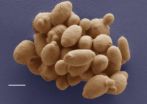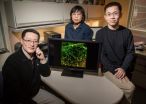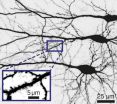(Press-News.org) More than 1.1 million spouses, parents and friends are caring for the injured and disabled who have served in the U.S. military since Sept. 11, 2001, often doing so without a formal support network and putting their own well-being at risk, according to a new RAND Corporation study.
The largest-ever study of military caregivers -- commissioned by the Elizabeth Dole Foundation -- finds that Americans who are taking care of veterans who served after 9/11 are younger than other caregivers, are usually employed outside the home and are more likely to care for someone who has a behavioral health problem.
Caregivers who assist post-9/11 veterans provide an estimated $3 billion in care annually and the work of all military caregivers saves the nation substantial sums in avoided long-term care costs. But despite these contributions, researchers found there are few public or private programs that directly support the needs of military caregivers.
"After more than a decade of war, the toll faced by the nation's caregivers who aid veterans and military members is large and can be expected to grow in the decades ahead," said Terri Tanielian, the study's co-leader and a senior social research analyst at RAND, a nonprofit research organization. "Until now, the needs of this group have been poorly understood."
As injured veterans recover and reintegrate into civilian life, many are aided by the support
and assistance of nonprofessional or informal caregivers, individuals who provide
a broad range of care and assistance with activities of daily living. That care can include activities such as bathing and eating, as well as making medical appointments, managing finances, caring for children and helping manage situations that could exacerbate mental health symptoms.
While caregiving for the elderly and the disabled has been well studied, little has been known about the population of those who care for military personnel and veterans.
"This study provides compelling details behind the incredible stories of selfless duty and sacrifice being demonstrated by millions of military caregivers across America," said U.S. Sen. Elizabeth Dole. "The findings confirm this is an urgent societal crisis and will serve as a call to action in galvanizing communities and inspiring individuals and organizations to raise awareness and increase support for our nation's hidden heroes."
The RAND report is based on the largest and most-comprehensive survey conducted of military caregivers in the United States. Researchers surveyed a representative sample of more than 1,100 military caregivers and compared their experiences to both civilian caregivers and noncaregivers.
In addition, researchers searched for public and private programs that may either directly or indirectly aid military caregivers, such as efforts that provide respite care or caregiving training. This effort included interviews with 82 organizations to understand the history, funding and objectives of such programs.
The RAND study estimates there are 5.5 million military caregivers across the United States, with nearly 20 percent caring for someone who served in the military since the terrorist attacks of Sept. 11, 2001.
Compared to older military caregivers, those who care for post-9/11 veterans tend to be younger, diverse and are more likely to care for someone with a mental health or behavioral health problem, be a veteran themselves, be employed and not be connected to a support network that aids in caregiving.
The caregivers who serve post-9/11 military members typically assist with fewer basic functional tasks than other types of caregivers, but are more likely to help a veteran cope with emotional and behavioral challenges.
Researchers found the time demands on military caregivers are substantial. Twelve percent of post-9/11 caregivers and 10 percent of pre-9/11 military caregivers report spending more than 40 hours per week providing care.
While civilian caregivers reported missing one day of work per month, post-9/11 military caregivers report missing 3.5 days of work per month. The report estimates the value of this lost productivity at $5.9 billion annually. The lost wages add to the financial strain faced by these caregivers.
Researchers found that military caregivers consistently experience more health problems than noncaregivers, face greater strains in family relationships and have more workplace problems than noncaregivers. The issues were most acute among caregivers who assist someone who served in the military after 9/11.
"Caring for a loved one is a demanding and difficult task, often doubly so for caregivers who juggle these activities with caring for a family and the demands of a job," said Rajeev Ramchand, the study's co-leader and a RAND senior behavioral scientist. "These caregivers pay a price for their devotion."
Military caregivers who assist a post-9/11 veteran face elevated risks for depression that is four times that of noncaregivers. RAND researchers found that more than 30 percent of these military caregivers lack health care coverage, suggesting they face added barriers to receiving help for their own health needs.
Researchers identified more than 100 programs that report offering services to military caregivers, but few target their services directly to caregivers. Most of the programs targeted the veteran, with family members who serve as caregivers invited to participate. Programs that do target caregivers typically are focused on older caregivers, not the younger caregivers who aid post-9/11 military members.
"There is an acute shortage of efforts to provide services directly for military caregivers," Ramchand said. "There is a particular need for programs that focus on the younger caregivers who aid the newest veterans."
Researchers say changes are needed to both provide assistance to military caregivers and to help them make plans for the future.
Priority should be given to strategies that strengthen and empower caregivers, such as training to help caregivers better understand their roles and develop the skills necessary to provide care and navigate social support networks. Efforts are needed to create caregiver-friendly environments, such as workplaces that can adapt to the flexible time needs of military caregivers.
In addition, more programs should focus specifically on the needs of military caregivers, providing support based on the duties they perform rather than their relationship to the care recipient. Those services include respite care that provides caregivers a short-term break and better access to health services.
Future planning efforts should help caregivers create financial and legal plans to ensure caregiving continuity for care recipients. Such services should be integrated into existing services and organizations through formal partnerships.
INFORMATION:
The report, "Hidden Heroes: America's Military Caregivers," is available at http://www.rand.org/military-caregivers. Other authors of the study are Michael P. Fisher, Christine Anne Vaughan, Thomas E. Trail, Caroline Epley, Phoenix Voorhies, Michael William Robbins, Eric Robinson and Bonnie Ghosh-Dastidar.
The Elizabeth Dole Foundation was founded to uplift American military caregivers by strengthening the services afforded to them through innovation, evidence-based research and collaboration. Information about the foundation's vision and approach can be found at http://www.dolemilitaryfamilies.org.
1.1 million Americans caring for recently wounded veterans, study finds
More help urged to aid military caregivers
2014-04-01
ELSE PRESS RELEASES FROM THIS DATE:
Customers prefer restaurants that offer nutrition facts and healthful foods
2014-04-01
Customers are more likely to frequent restaurants that provide both healthful foods and nutrition information, according to researchers at Penn State and the University of Tennessee.
"The Affordable Care Act has mandated that chain restaurants -- those with more than 20 restaurants -- provide nutrition information to customers," said David Cranage, associate professor of hospitality management. "Many restaurants had been fighting this legislation because they thought they would lose customers if the customers knew how unhealthy their food was. In this study, we found ...
New yeast species travelled the globe with a little help from the beetles
2014-04-01
Researchers from the National Collection of Yeast Cultures (NCYC) at the Institute of Food Research (IFR) have identified a new globe-trotting yeast species that lives on tree-associated beetles. This new species demonstrates the importance of preserving biodiversity, as yeasts like this may help efforts to develop renewable fuel sources in the future.
Preserving biodiversity must go beyond plants and animals and also preserve the microbial life. Threats to habitats, for example through oil exploration, could destroy forever potential solutions to global challenges locked ...
Simple changes in ICU can help heart attack patients: Study
2014-04-01
To improve recovery for heart attack patients, hospitals should maintain normal day and night cycles for those patients during the first few days after the attack, say University of Guelph researchers.
Their new study shows for the first time that interrupting diurnal rhythms impairs healing immediately after a heart attack, said Prof. Tami Martino of the Department of Biomedical Sciences.
Researchers already knew that circadian rhythms, or day-night cycles, can affect timing of a heart attack. This is the first study to show the importance of circadian rhythms during ...
Dog watch
2014-04-01
Dogs are individual personalities, possess awareness, and are particularly known for their learning capabilities, or trainability. To learn successfully, they must display a sufficient quantity of attention and concentration. However, the attentiveness of dogs' changes in the course of their lives, as it does in humans. The lead author Lisa Wallis and her colleagues investigated 145 Border Collies aged 6 months to 14 years in the Clever Dog Lab at the Vetmeduni Vienna and determined, for the first time, how attentiveness changes in the entire course of a dog's life using ...
Experts demand lead ammunition be replaced by steel in shooting sports
2014-04-01
Raimon Guitart, lecturer in Toxicology at the UAB, and Vernon Thomas, emeritus professor of the University of Guelph, analysed in detail the environmental effects of using lead ammunition in shooting sports, in an article published in the AMBIO journal. Although the number of Olympic athletes specialising in these sports is reduced, and the ammunition is recovered and recycled after the competitions, there are many amateurs who practice this sport around the world, making it almost impossible to recover the ammunition after being used.
Researchers show that for these ...
Carbon nanotubes grow in combustion flames
2014-04-01
Nagoya, Japan – Professor Stephan Irle of the Institute of Transformative Bio-Molecules (WPI-ITbM) at Nagoya University and co-workers at Kyoto University, Oak Ridge National Lab (ORNL), and Chinese research institutions have revealed through theoretical simulations that the molecular mechanism of carbon nanotube (CNT) growth and hydrocarbon combustion actually share many similarities. In studies using acetylene molecules (ethyne; C2H2, a molecule containing a triple bond between two carbon atoms) as feedstock, the ethynyl radical (C2H), a highly reactive molecular intermediate ...
Early intervention reduces aggressive behavior in adulthood
2014-04-01
An educational intervention program for children between kindergarten and 10th grade, known as Fast Track, reduces aggressive behavior later in life, according to research published in Psychological Science, a journal of the Association for Psychological Science.
The research, led by psychological scientist Justin Carré of Nipissing University in Ontario, Canada, indicates that dampened testosterone levels in response to social threats may account for the intervention's success in reducing aggression.
The Fast Track intervention program teaches children social cognitive ...
Team finds a better way to grow motor neurons from stem cells
2014-04-01
CHAMPAIGN, Ill. — Researchers report they can generate human motor neurons from stem cells much more quickly and efficiently than previous methods allowed. The finding, described in Nature Communications, will aid efforts to model human motor neuron development, and to understand and treat spinal cord injuries and motor neuron diseases such as amyotrophic lateral sclerosis (ALS).
The new method involves adding critical signaling molecules to precursor cells a few days earlier than previous methods specified. This increases the proportion of healthy motor neurons derived ...
Science: Switching brain cells with less light
2014-04-01
This news release is available in German. Networked nerve cells are the control center of organisms. In a nematode, 300 nerve cells are sufficient to initiate complex behavior. To understand the properties of the networks, re-searchers switch cells on and off with light and observe the resulting behavior of the organism. In the Science journal, sci-entists now present a protein that facilitates the control of nerve cells by light. It might be used as a basis of studies of diseases of the nervous system. DOI: 10.1126/science.1249375
To switch a nerve cell with light, ...
Gratitude, not 'gimme,' makes for more satisfaction, Baylor University study finds
2014-04-01
People who are materialistic are more likely to be depressed and unsatisfied, in part because they find it harder to be grateful for what they have, according to a study by Baylor researchers.
The study — "Why are materialists less happy? The role of gratitude and need satisfaction in the relationship between materialism and life satisfaction" — appears in the journal Personality and Individual Differences.
"Gratitude is a positive mood. It's about other people," said study lead author Jo-Ann Tsang, Ph.D., associate professor of psychology and neuroscience in Baylor's ...
LAST 30 PRESS RELEASES:
Tracing the quick synthesis of an industrially important catalyst
New software sheds light on cancer’s hidden genetic networks
UT Health San Antonio awarded $3 million in CPRIT grants to bolster cancer research and prevention efforts in South Texas
Third symposium spotlights global challenge of new contaminants in China’s fight against pollution
From straw to soil harmony: International team reveals how biochar supercharges carbon-smart farming
Myeloma: How AI is redrawing the map of cancer care
Manhattan E. Charurat, Ph.D., MHS invested as the Homer and Martha Gudelsky Distinguished Professor in Medicine at the University of Maryland School of Medicine
Insilico Medicine’s Pharma.AI Q4 Winter Launch Recap: Revolutionizing drug discovery with cutting-edge AI innovations, accelerating the path to pharmaceutical superintelligence
Nanoplastics have diet-dependent impacts on digestive system health
Brain neuron death occurs throughout life and increases with age, a natural human protein drug may halt neuron death in Alzheimer’s disease
SPIE and CLP announce the recipients of the 2025 Advanced Photonics Young Innovator Award
Lessons from the Caldor Fire’s Christmas Valley ‘Miracle’
Ant societies rose by trading individual protection for collective power
Research reveals how ancient viral DNA shapes early embryonic development
A molecular gatekeeper that controls protein synthesis
New ‘cloaking device’ concept to shield sensitive tech from magnetic fields
Researchers show impact of mountain building and climate change on alpine biodiversity
Study models the transition from Neanderthals to modern humans in Europe
University of Phoenix College of Doctoral Studies releases white paper on AI-driven skilling to reduce burnout and restore worker autonomy
AIs fail at the game of visual “telephone”
The levers for a sustainable food system
Potential changes in US homelessness by ending federal support for housing first programs
Vulnerability of large language models to prompt injection when providing medical advice
Researchers develop new system for high-energy-density, long-life, multi-electron transfer bromine-based flow batteries
Ending federal support for housing first programs could increase U.S. homelessness by 5% in one year, new JAMA study finds
New research uncovers molecular ‘safety switch’ shielding cancers from immune attack
Bacteria resisting viral infection can still sink carbon to ocean floor
Younger biological age may increase depression risk in older women during COVID-19
Bharat Innovates 2026 National Basecamp Showcases India’s Most Promising Deep-Tech Ventures
Here’s what determines whether your income level rises or falls
[Press-News.org] 1.1 million Americans caring for recently wounded veterans, study findsMore help urged to aid military caregivers




